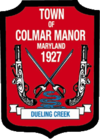Colmar Manor, Maryland
| Colmar Manor, Maryland | ||
|---|---|---|
| Town | ||
| Town of Colmar Manor | ||
|
||
 Location of Colmar Manor, Maryland |
||
| Coordinates: 38°56′2″N 76°56′49″W / 38.93389°N 76.94694°WCoordinates: 38°56′2″N 76°56′49″W / 38.93389°N 76.94694°W | ||
| Country | ||
| State |
|
|
| County | ||
| Area | ||
| • Total | 0.52 sq mi (1.35 km2) | |
| • Land | 0.47 sq mi (1.22 km2) | |
| • Water | 0.05 sq mi (0.13 km2) | |
| Elevation | 30 ft (9 m) | |
| Population (2010) | ||
| • Total | 1,404 | |
| • Estimate (2012) | 1,429 | |
| • Density | 2,987.2/sq mi (1,153.4/km2) | |
| Time zone | Eastern (EST) (UTC-5) | |
| • Summer (DST) | EDT (UTC-4) | |
| ZIP code | 20722 | |
| Area code(s) | 301 | |
| FIPS code | 24-18850 | |
| GNIS feature ID | 0597270 | |
| Website | http://colmarmanor.org | |
Colmar Manor is a town located in Prince George's County, Maryland, in the United States. As of the 2010 census, the town had a population of 1,404. As the town developed at the beginning of the 20th century, it assumed a name derived from its proximity to the District of Columbia—the first syllable of Columbia and that of Maryland were combined to form "Colmar". Colmar Manor was incorporated in 1927.
The town is home to Dueling Creek, formerly in Bladensburg, Maryland, a small waterway that because of its secluded location was a popular site for dueling. Duels were banned in neighboring Washington, D.C., but legal in Maryland, and Dueling Creek was the site for more than 50 duels between 1808 and 1868. The most famous duel fought on the site was on March 22, 1820, between Stephen Decatur and James Barron. Decatur was mortally wounded in the exchange.
During the War of 1812, on August 24, 1814, the area was the scene of the Battle of Bladensburg. The place became a battlefield again in the early days of the Civil War when Confederate troops mounted an assault on Battery Jameson, Fort Lincoln, now northeast Washington, D.C., which was one of a number Union defensive forts built around the nation's capital to protect it from capture. The remains of Fort Lincoln are located on the hillside that is now a part of Fort Lincoln Cemetery.
In 1912, the Capitol Cemetery of Prince George's County was incorporated on the Washington, D.C., boundary line. Directly north of the cemetery was the Shreve estate. The Shreve house was destroyed in the 1890s. The 260-acre (1.1 km2) farm site was used by the 6,000 jobless men from Ohio who descended on the Capitol in 1894 as "Coxey's Army". Bladensburg Road traversed the area, becoming more heavily traveled in the 1920s, and eventually became designated as U.S. Route 1. Part of the former Shreve estate was subdivided into building lots in 1918. The lots were 50 feet (15 m) wide by 100 feet (30 m) deep, arranged along a grid pattern of streets. The streets were originally named after President Woodrow Wilson (1913–21), members of his cabinet, and other prominent men of the era. Some time later, the streets were renamed to conform to the system in use in the District of Columbia. The location of the development within the first service area of the Washington Suburban Sanitary Commission offered homeowners modern water and sewer lines. The houses constructed were modest one- and two-story wood-frame buildings. In 1931, the town's streets were paved and gutters were installed. A concrete block municipal building was constructed in 1934, followed by the construction of a brick schoolhouse in 1935. In 1959, a new municipal building was constructed to house the town's administrative offices and police department.
...
Wikipedia

